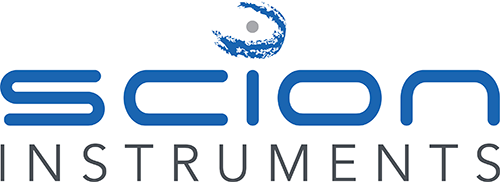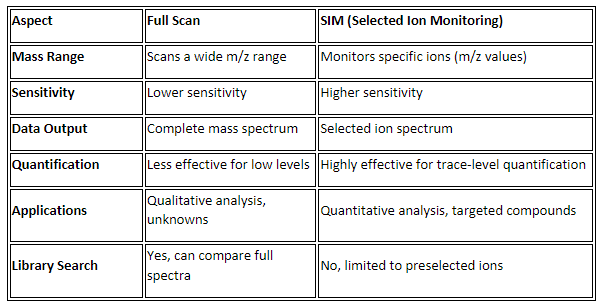What is the difference between Full Scan/SIM (selective ion monitoring)?
Full Scan and SIM (Selected Ion Monitoring) are two different data acquisition modes used in Quadrupole Mass Spectrometry, and each has specific applications depending on the requirements of the analysis.
Full Scan mode
How It Works:
In Full Scan mode, the mass spectrometer sweeps across a broad range of mass-to-charge ratios (m/z), typically spanning from m/z 50 to 500. It records the intensity of all ions within this range.
Advantages:
- Comprehensive Analysis: Captures a complete mass spectrum, offering detailed structural information across a wide m/z range.
- Detection of Unknown Compounds: Ideal for discovering unknown compounds since it detects all ions in the selected range.
- Library Matching: Enables comparison with mass spectral libraries (e.g., NIST) for identifying compounds based on fragmentation patterns.
Limitations:
- Lower Sensitivity: Scanning a wide m/z range means the detector’s time is divided, reducing sensitivity for specific ions.
- Weaker Quantification: Generates fewer data points and has a lower signal-to-noise ratio compared to SIM, though optimization can improve performance.
When to Use Full Scan:
- Ideal for qualitative analysis aimed at identifying unknown compounds.
- Useful during method development, exploratory research, or analyzing complex mixtures.
SIM (Selected Ion Monitoring) mode
How It Works:
SIM focuses on monitoring specific, pre-selected ions (m/z values) that are characteristic of the target compounds, rather than scanning the full range. This increases both sensitivity and selectivity.
Advantages:
- High Sensitivity: By concentrating on a few ions, SIM dramatically boosts sensitivity, allowing detection of trace amounts.
- High Selectivity: Reduces background noise and improves the clarity of signals from target analytes in complex matrices.
- Better Quantification: Provides more reliable and accurate measurements with an enhanced signal-to-noise ratio.
Limitations:
- Limited Detection: Only pre-selected ions are detected, meaning any other compounds go unnoticed.
- No Structural Insights: Doesn’t provide full-spectrum data, making it unsuitable for identifying unknown compounds.
When to Use SIM:
- Best for targeted quantitative analysis of known compounds.
- Ideal for highly sensitive applications such as pharmaceutical testing, environmental monitoring, and food safety.
Choosing Full Scan or SIM:
Full Scan: Use when you need detailed information about a broad range of compounds, especially for identifying unknowns or comparing spectra with a library.
SIM: Use when you want to focus on a few known compounds and require the highest possible sensitivity for quantification or trace analysis.
Summary of Differences:

